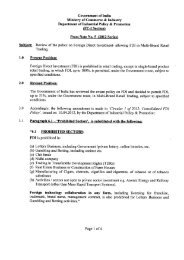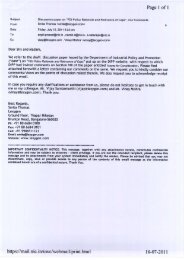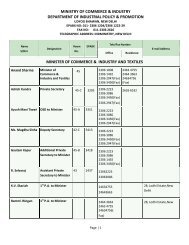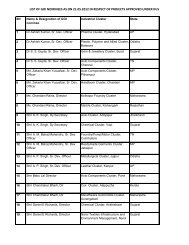fdi in india and its growth linkages - Department Of Industrial Policy ...
fdi in india and its growth linkages - Department Of Industrial Policy ...
fdi in india and its growth linkages - Department Of Industrial Policy ...
You also want an ePaper? Increase the reach of your titles
YUMPU automatically turns print PDFs into web optimized ePapers that Google loves.
FDI IN INDIA AND ITS GROWTH LINKAGES<br />
a partner country may switch to another country. Thus, the current methodology to compile FDI statistics <strong>in</strong> India needs<br />
to be revised to better reflect foreign direct <strong>in</strong>vestment positions (stocks) <strong>and</strong> transactions (flows).<br />
8.3 OECD Methodology<br />
In April 2008, the Organisation of Economic Cooperation <strong>and</strong> Development (OECD) brought out the fourth edition<br />
of the Benchmark Def<strong>in</strong>ition of Foreign Direct Investment. This <strong>in</strong>corporates recent changes <strong>in</strong> terms of the activities<br />
of mult<strong>in</strong>ational enterprises <strong>and</strong> types of <strong>in</strong>vestments these enterprises are undertak<strong>in</strong>g across countries.<br />
Accord<strong>in</strong>g to OECD (2008), “foreign direct <strong>in</strong>vestment reflects the objective of establish<strong>in</strong>g a last<strong>in</strong>g <strong>in</strong>terest by a<br />
resident enterprise <strong>in</strong> one economy (direct <strong>in</strong>vestor) <strong>in</strong> an enterprise (direct <strong>in</strong>vestment enterprise) that is resident <strong>in</strong> an<br />
economy other than that of the direct <strong>in</strong>vestor” (p.15). The purpose of establish<strong>in</strong>g a long-term relationship by a direct<br />
<strong>in</strong>vestor with the direct <strong>in</strong>vestment enterprise is to exercise a significant <strong>in</strong>fluence on the management of the direct<br />
<strong>in</strong>vestment enterprise. The “last<strong>in</strong>g <strong>in</strong>terest” is acquired when the direct <strong>in</strong>vestor owns at least 10 per cent of the vot<strong>in</strong>g<br />
power <strong>in</strong> the direct <strong>in</strong>vestment enterprise. Though op<strong>in</strong>ions are divided on the cut-off percentage of vot<strong>in</strong>g power to be<br />
held by the direct <strong>in</strong>vestor to have an effective voice <strong>in</strong> the management of the direct <strong>in</strong>vestment enterprise, the OECD<br />
recommends the 10 per cent threshold to ensure statistical consistency across countries. The OECD’s Benchmark<br />
Def<strong>in</strong>ition embraces the concepts <strong>and</strong> def<strong>in</strong>itions of the International Monetary Fund’s Balance of Payments <strong>and</strong><br />
International Investment Positions Manual (BPM) as well as the System of National Accounts of the Commission of<br />
the European Communities, the International Monetary Fund, OECD, the United Nations <strong>and</strong> the World Bank.<br />
8.4 Concept of Economic Territory <strong>and</strong> Residence<br />
Foreign direct <strong>in</strong>vestment <strong>in</strong>cludes transactions/positions between a resident <strong>and</strong> a non-resident <strong>in</strong>stitutional unit. It<br />
excludes all transactions/positions between un<strong>its</strong> that are residents of the same country. Thus, the concept of residence<br />
is important <strong>in</strong> determ<strong>in</strong><strong>in</strong>g cross-border <strong>in</strong>vestments between residents of two or more economic territories. Each<br />
<strong>in</strong>stitutional unit 1 is considered as a resident of one <strong>and</strong> only one economic territory. 2 Accord<strong>in</strong>g to the System of<br />
National Accounts, there are two types of <strong>in</strong>stitutional un<strong>its</strong>, viz., households, <strong>and</strong> legal <strong>and</strong> social entities. Households<br />
can be direct <strong>in</strong>vestors but not direct <strong>in</strong>vestment enterprises. Legal <strong>and</strong> social entities <strong>in</strong>clude governments, corporations<br />
<strong>and</strong> non-profit <strong>in</strong>stitutions; they also <strong>in</strong>clude quasi-corporations, which are un<strong>in</strong>corporated enterprises belong<strong>in</strong>g to<br />
households or government un<strong>its</strong>, <strong>and</strong> they may behave <strong>in</strong> much the same ways as corporations. While only bus<strong>in</strong>ess<br />
enterprises can be both direct <strong>in</strong>vestors <strong>and</strong> direct <strong>in</strong>vestment enterprises, government <strong>and</strong> non-profit organisations can<br />
be direct <strong>in</strong>vestors but not direct <strong>in</strong>vestment enterprises. Though some un<strong>its</strong> like households may have l<strong>in</strong>ks with more<br />
than one economy, for statistical consistency they are attached to a s<strong>in</strong>gle economic territory.<br />
The Benchmark Def<strong>in</strong>ition does not classify foreign direct statistics by <strong>in</strong>stitutional sectors, i.e., enterprise (legal <strong>and</strong><br />
social entities) types <strong>in</strong>clud<strong>in</strong>g corporations, quasi-corporations, branch, estates, other trusts <strong>and</strong> partnerships <strong>and</strong> special<br />
corporate structures. 3 However, it is important to underst<strong>and</strong> these <strong>in</strong>stitutional structures <strong>in</strong> determ<strong>in</strong><strong>in</strong>g whether a<br />
particular transaction or position should be <strong>in</strong>cluded <strong>in</strong> foreign direct <strong>in</strong>vestment statistics. The classification of resident<br />
or non-resident <strong>in</strong>stitutional sectors is based on the pr<strong>in</strong>cipal product or products produced or distributed or service<br />
rendered by various enterprise types.<br />
Five <strong>in</strong>stitutional sectors are classified by the Benchmark Def<strong>in</strong>ition <strong>and</strong> are the same sectors that are reported by the<br />
System of National Accounts. These are the non-f<strong>in</strong>ancial corporation sector, f<strong>in</strong>ancial corporation sector, government<br />
1. Institutional unit is an economic entity that is capable, <strong>in</strong> <strong>its</strong> own right, of own<strong>in</strong>g assets, <strong>in</strong>curr<strong>in</strong>g liabilities <strong>and</strong> engag<strong>in</strong>g <strong>in</strong> economic activities <strong>and</strong> <strong>in</strong><br />
transactions with other entities.<br />
2. In the Benchmark Def<strong>in</strong>ition, "economic territory" has the dimension of physical location as well as legal jurisdiction <strong>and</strong> is under the economic control<br />
of a s<strong>in</strong>gle government. The Benchmark also considers economic territory as country. However, it does not adhere to any legal (nationality) or statistical<br />
(economy) def<strong>in</strong>ition.<br />
3. For def<strong>in</strong>itions of these terms, see OECD (2008), Chapter 3.<br />
92












